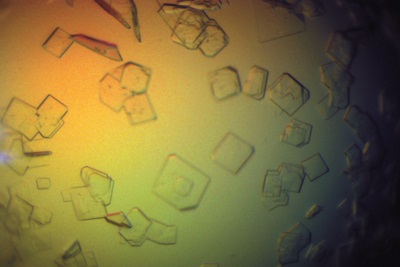Microseeding: a new way to overcome hemihedral twinning?
 Twinning is a crystal-growth disorder in which the specimen is composed of distinct domains whose orientations differ but are related in a particular, well-defined way. Twinning, which is a known problem in protein crystallography, usually hampers high-quality crystal structure determination unless it is detected and either avoided or corrected. Although effective computational methods have been developed for the determination of structures using data from twinned crystals (known as 'detwinning'), if possible it is preferable to obtain crystals that are not twinned.In some cases, optimising the length of the protein fragment used for crystallisation can lead to the growth of untwinned crystals, but this is a time-consuming process.
Twinning is a crystal-growth disorder in which the specimen is composed of distinct domains whose orientations differ but are related in a particular, well-defined way. Twinning, which is a known problem in protein crystallography, usually hampers high-quality crystal structure determination unless it is detected and either avoided or corrected. Although effective computational methods have been developed for the determination of structures using data from twinned crystals (known as 'detwinning'), if possible it is preferable to obtain crystals that are not twinned.In some cases, optimising the length of the protein fragment used for crystallisation can lead to the growth of untwinned crystals, but this is a time-consuming process.
In a recent paper in Acta Crystallographica Section F, microseeding was used to produce untwinned crystals of LigM, an O-demethylase from Sphingobium sp. SYK-6, using twinned crystals as seeds. Microseeding is one of several seeding techniques that are used to successfully separate nucleation events from crystal-growth events. In this technique, crystals are used as seeds and introduced into new drops which are equilibrated at lower levels of supersaturation. It has frequently been used to improve reproducibility in crystallization and can yield different crystal forms.
In the work described by Harada et al. [(2016). Acta Cryst. F72, 897-902; doi:10.1107/S2053230X16018665], around 50% of the initially obtained crystals of LigM were hemihedrally twinned. These crystals were then used as a seed stock for microseeding. In combination with optimization of the reservoir solution, this led to crystals that were not twinned and belonged to a different space group. It is hoped that this method will have potential as a more general simple method for overcoming hemihedral twinning in protein crystals.


